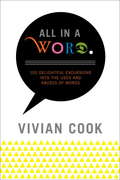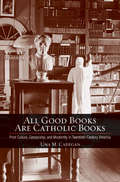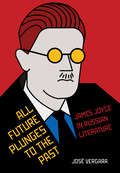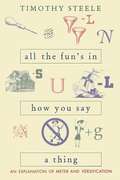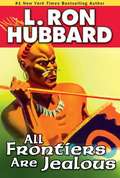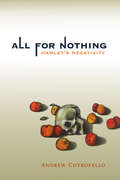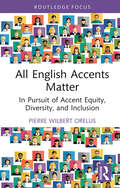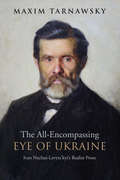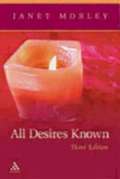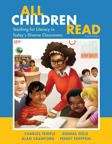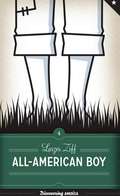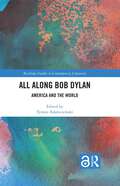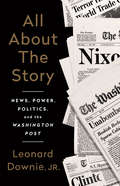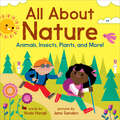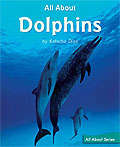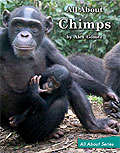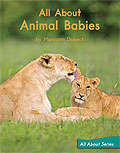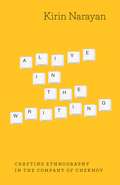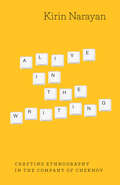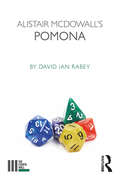- Table View
- List View
All in a Word: 100 Delightful Excursions into the Uses and Abuses of Words
by Vivian CookDelve into the hidden nature of words: An irresistible mix of information, curiosity, and fun. Linguist Vivian Cook takes us on a brilliant series of excursions into the history and meaning of words: How do we learn words as a child? How are words born, and why do they die? Why do some never get spoken, and others never written? Each chapter is charmingly illustrated—and accompanied by a rich assortment of games, lists, puzzles, and quotes. From polite words to crass words, from p-c words to Shakespeare’s words, from food and wine words to jazz and drug words—the book is an exciting exploration into the abundance and variety of words.
All Good Books Are Catholic Books: Print Culture, Censorship, and Modernity in Twentieth-Century America
by Una M. CadeganUntil the close of the Second Vatican Council in 1965, the stance of the Roman Catholic Church toward the social, cultural, economic, and political developments of the twentieth century was largely antagonistic. Naturally opposed to secularization, skeptical of capitalist markets indifferent to questions of justice, confused and appalled by new forms of high and low culture, and resistant to the social and economic freedom of women—in all of these ways the Catholic Church set itself up as a thoroughly anti-modern institution. Yet, in and through the period from World War I to Vatican II, the Church did engage with, react to, and even accommodate various aspects of modernity. In All Good Books Are Catholic Books, Una M. Cadegan shows how the Church’s official position on literary culture developed over this crucial period.The Catholic Church in the United States maintained an Index of Prohibited Books and the National Legion of Decency (founded in 1933) lobbied Hollywood to edit or ban movies, pulp magazines, and comic books that were morally suspect. These regulations posed an obstacle for the self-understanding of Catholic American readers, writers, and scholars. But as Cadegan finds, Catholics developed a rationale by which they could both respect the laws of the Church as it sought to protect the integrity of doctrine and also engage the culture of artistic and commercial freedom in which they operated as Americans. Catholic literary figures including Flannery O’Connor and Thomas Merton are important to Cadegan’s argument, particularly as their careers and the reception of their work demonstrate shifts in the relationship between Catholicism and literary culture. Cadegan trains her attention on American critics, editors, and university professors and administrators who mediated the relationship among the Church, parishioners, and the culture at large.
All Future Plunges to the Past: James Joyce in Russian Literature (NIU Series in Slavic, East European, and Eurasian Studies)
by José VergaraAll Future Plunges to the Past explores how Russian writers from the mid-1920s on have read and responded to Joyce's work. Through contextually rich close readings, José Vergara uncovers the many roles Joyce has occupied in Russia over the last century, demonstrating how the writers Yury Olesha, Vladimir Nabokov, Andrei Bitov, Sasha Sokolov, and Mikhail Shishkin draw from Joyce's texts, particularly Ulysses and Finnegans Wake, to address the volatile questions of lineages in their respective Soviet, émigré, and post-Soviet contexts. Interviews with contemporary Russian writers, critics, and readers of Joyce extend the conversation to the present day, showing how the debates regarding the Irish writer's place in the Russian pantheon are no less settled one hundred years after Ulysses.The creative reworkings, or "translations," of Joycean themes, ideas, characters, plots, and styles made by the five writers Vergara examines speak to shifting cultural norms, understandings of intertextuality, and the polarity between Russia and the West. Vergara illuminates how Russian writers have used Joyce's ideas as a critical lens to shape, prod, and constantly redefine their own place in literary history.All Future Plunges to the Past offers one overarching approach to the general narrative of Joyce's reception in Russian literature. While each of the writers examined responded to Joyce in an individual manner, the sum of their methods reveals common concerns. This subject raises the issue of cultural values and, more importantly, how they changed throughout the twentieth century in the Soviet Union, Russian emigration, and the post-Soviet Russian environment.
All The Fun's In How You Say A Thing: An Explanation Of Meter And Versification
by Timothy SteelePerfect for the general reader of poetry, students and teachers of literature, and aspiring poets, All the Fun’s in How You Say a Thing is a lively and comprehensive study of versification by one of our best contemporary practitioners of traditional poetic forms. Emphasizing both the coherence and the diversity of English metrical practice from Chaucer’s time to ours, Timothy Steele explains how poets harmonize the fixed units of meter with the variable flow of idiomatic speech. He examines the ways in which poets have used meter, rhyme, and stanza to communicate and enhance meaning. Steele illuminates as well many practical, theoretical, and historical issues in English prosody, without ever losing sight of the fundamental pleasures, beauties, and insights that fine poems offer us. Written lucidly, with a generous selection of helpful scansions and explanations of the metrical effects of the great poets of the English language, All the Fun’s in How You Say a Thing is not only a valuable handbook on technique; it is also a wide-ranging study of English verse and a mine of entertaining information for anyone wishing more fully to write, enjoy, understand, or teach poetry.
All Frontiers Are Jealous
by L. Ron HubbardExplore this larger than life tale. American engineer Dan Courtney is surveying the route of the Sudan Railway in Africa, linking the Uganda Railway with the Anglo-Egyptian Railroad--a project that seems doomed to fail.When he finds that a young American woman has been kidnapped by the most feared tribe on the continent, the Dinkas, it lands him in an action-swept, life-or-death confrontation to save the girl. The battle with the Dinkas will determine not only the fate of the railway system, but reveal the identity of a killer stalking the girl. "...the stories' fast-moving pace is sure to keep listeners enthralled. Great fun for nostalgia buffs, recommended for tweens and up." --Library Journal
All for Nothing: Hamlet's Negativity (Short Circuits)
by Andrew CutrofelloHamlet as performed by philosophers, with supporting roles played by Kant, Nietzsche, and others.A specter is haunting philosophy—the specter of Hamlet. Why is this? Wherefore? What should we do?Entering from stage left: the philosopher's Hamlet. The philosopher's Hamlet is a conceptual character, played by philosophers rather than actors. He performs not in the theater but within the space of philosophical positions. In All for Nothing, Andrew Cutrofello critically examines the performance history of this unique role. The philosopher's Hamlet personifies negativity. In Shakespeare's play, Hamlet's speech and action are characteristically negative; he is the melancholy Dane. Most would agree that he has nothing to be cheerful about. Philosophers have taken Hamlet to embody specific forms of negativity that first came into view in modernity. What the figure of the Sophist represented for Plato, Hamlet has represented for modern philosophers. Cutrofello analyzes five aspects of Hamlet's negativity: his melancholy, negative faith, nihilism, tarrying (which Cutrofello distinguishes from “delaying”), and nonexistence. Along the way, we meet Hamlet in the texts of Kant, Coleridge, Hegel, Marx, Schopenhauer, Kierkegaard, Nietzsche, Freud, Russell, Wittgenstein, Heidegger, Benjamin, Arendt, Schmitt, Lacan, Deleuze, Foucault, Derrida, Badiou, Žižek, and other philosophers. Whirling across a kingdom of infinite space, the philosopher's Hamlet is nothing if not thought-provoking.
All for Love
by Ved MehtaVed Mehta joined the staff of The New Yorker in the 1960s, blind since the age of four and already on his way to a career as a writer. In a series of four relationships he demanded that his lovers, like him, pretend he could see. With lyrical and stirring accuracy, Mehta revisits these love affairs today, tracing the links between his denial of his disability and the cruel transformations that each of his lovers underwent. “Poignant and occasionally hilarious.”-The New York Times Book Review. “This elegant volume remains a striking piece of insight into the nature of love.”-Publishers Weekly. “[An] excoriatingly truthful and heartbreaking account of the pursuit and loss of love. ...”-The Times of London. “A mesmerizing account ... the most arresting passages are Mehta’s mind-expanding descriptions of how he perceives the world. ”-Booklist.
All English Accents Matter: In Pursuit of Accent Equity, Diversity, and Inclusion (Routledge Studies in Sociolinguistics)
by Pierre Wilbert OrelusOrelus' valuable study draws on the scholarly work of sociocultural and postcolonial theorists, as well as testimonies collected from study participants, to explore accentism, the systemic form of discrimination against speakers whose accents deviate from a socially constructed norm. Orelus examines the manner in which accents are acquired and the effects of such acquisition on the learning and educational experiences of linguistically and culturally diverse students. He goes on to demonstrate the ways and the degree to which factors such as race, class, and country of origin are connected with nonstandard accent-based discrimination. Finally, this book proposes alternative ways to challenge and counter the accentism that minority groups, including linguistically and culturally diverse groups, have faced in schools and in society at large. It will be of interest to all of those concerned with linguistic/accent-based prejudice and the experience of those who face it.
The All-Encompassing Eye of Ukraine
by Maxim TarnawskyOne of the most important realist novelists of nineteenth-century Ukraine, Ivan Nechui-Levyts'kyi was caricatured and then forgotten by a generation of literary modernists who rejected his aesthetic and ideological views. In The All-Encompassing Eye of Ukraine, Maxim Tarnawsky presents a thorough and much-needed reexamination of Nechui-Levyts'kyi and his work.A solitary, modest man whose chief interest was in promoting and defending a Ukrainian identity threatened by the cultural policies of the Russian Empire, Levyts'kyi's writing described Ukraine, its people, its culture, and the forces threatening it. A satirist who attacked modernism and cosmopolitanism, he wrote in a style marked by what Tarnawsky calls non-purposeful narration - slow-paced humour built on rhetorical finesse rather than on plot or character development.A vital reconsideration of a significant Ukrainian novelist written by the foremost expert on his work, The All-Encompassing Eye of Ukraine deepens and expands our understanding of Ukraine's nineteenth-century literature.
All Ears: The Aesthetics of Espionage
by Roland Végső Peter SzendyThe world of international politics has recently been rocked by a seemingly endless series of scandals involving auditory surveillance: the NSA’s warrantless wiretapping is merely the most sensational example of what appears to be a universal practice today. What is the source of this generalized principle of eavesdropping? All Ears: The Aesthetics of Espionage traces the long history of moles from the Bible, through Jeremy Bentham’s “panacoustic” project, all the way to the intelligence-gathering network called “Echelon.” Together with this archeology of auditory surveillance, Szendy offers an engaging account of spycraft’s representations in literature (Sophocles, Shakespeare, Joyce, Kafka, Borges), opera (Monteverdi, Mozart, Berg), and film (Lang, Hitchcock, Coppola, De Palma). Following in the footsteps of Orpheus, the book proposes a new concept of “overhearing” that connects the act of spying to an excessive intensification of listening. At the heart of listening Szendy locates the ear of the Other that manifests itself as the originary division of a “split-hearing” that turns the drive for mastery and surveillance into the death drive.
All Desires Known
by Janet MorleyA classic and indispensable resource for public worship and private devotion that speaks to people across a range of traditions - both within and beyond the church. Composed in response to the desire for worship language of worship that's inclusive of women's experience yet deeply rooted in the words, stories, and images of Scripture, they have resonated not only with women, but with all who love the Bible and who want to pray with honesty and directness. <P><P> This new edition introduces a fresh selection of material on themes of global justice, as well as a contemporary Eucharist and prayers that coincide with the Revised Common Lectionary.
All Children Read: Teaching For Literacy In Today's Diverse Classrooms (Fourth Edition)
by Charles A. Temple Donna Ogle Alan N. Crawford Penny FrepponWritten by one of the most dynamic author teams in the field of Reading and Literacy, the Fourth Edition of All Children Read continues to offer K-8 teachers the best practices for developing reading and writing in all students. The new edition integrates Common Core State Standards, deepens its exploration of Response to Intervention (RTI), looks more deeply at comprehension of informational text, and emphasizes the teaching of English Language Learners. Central to, and woven throughout, this text are the six overriding themes-the struggling reader; family/community literacy; new literacies; writing and reading connections; developmental, cultural, and linguistic diversity; and phonics/phonological awareness. This title is also available packaged with the Enhanced Pearson eText. To order the Enhanced Pearson eText packaged with a bound book, use ISBN 0133388204.
All-American Boy
by Larzer ZiffFrom his celebrated appearance, hatchet in hand, in Parson Mason Locke Weems's Life of Washington to Booth Tarkington's Penrod, the all-American boy was an iconic figure in American literature for well over a century. Sometimes he was a "good boy," whose dutiful behavior was intended as a model for real boys to emulate. Other times, he was a "bad boy," whose mischievous escapades could be excused either as youthful exuberance that foreshadowed adult industriousness or as deserved attacks on undemocratic pomp and pretension. But whether good or bad, the all-American boy was a product of the historical moment in which he made his appearance in print, and to trace his evolution over time is to take a fresh view of America's cultural history, which is precisely what Larzer Ziff accomplishes in All-American Boy. Ziff looks at eight classic examples of the all-American boy-young Washington, Rollo, Tom Bailey, Tom Sawyer, Ragged Dick, Peck's "bad boy," Little Lord Fauntleroy, and Penrod-as well as two notable antitheses-Huckleberry Finn and Holden Caulfield. Setting each boy in a rich cultural context, Ziff reveals how the all-American boy represented a response to his times, ranging from the newly independent nation's need for models of democratic citizenship, to the tales of rags-to-riches beloved during a century of accelerating economic competition, to the recognition of adolescence as a distinct phase of life, which created a stage on which the white, middle class "solid citizen" boy and the alienated youth both played their parts.
All Along Bob Dylan: America and the World (Routledge Studies in Contemporary Literature)
by J. Roger KurtzAll Along Bob Dylan: America and the World offers an important contribution to thinking about the artist and his work. Adding European and non-English speaking contexts to the vibrant field of Dylan studies, the volume covers a wide range of topics and methodologies while dealing with the inherently complex and varied material produced or associated with the iconic artist. The chapters, organized around three broad thematic sections (Geographies, Receptions and Perspectives), address the notions of audience, performance and identity, allowing to map out the structure of feeling and authenticity, both, in the case of the artist and his audience. Taking its cue from the collapse of the so-called high-/ low culture split following from the Nobel Prize, the book explores the argument that Dylan (and all popular music) can be interpreted as literature and offers discussions in the context of literary traditions, or visual culture and music. This contributes to a nuanced and complex portrayal of the seminal cultural phenomenon called Bob Dylan.
All About the Story: News, Power, Politics, and the Washington Post
by Leonard Downie JrAt a time when the role of journalism is especially critical, the former executive editor of the Washington Post writes about his nearly fifty years at the newspaper and the importance of getting at the truth.In 1964, as a twenty-two-year-old Ohio State graduate with working-class Cleveland roots and a family to support, Len Downie landed an internship with the Washington Post. He would become a pioneering investigative reporter, news editor, foreign correspondent, and managing editor, before succeeding the legendary Ben Bradlee as executive editor.Downie's leadership style differed from Bradlee's, but he played an equally important role over more than four decades in making the Post one of the world's leading news organizations. He was one of the editors on the historic Watergate story and drove coverage of the impeachment of President Bill Clinton. He wrestled with the Unabomber's threat to kill more people unless the Post published a rambling 30,000-word manifesto and he published important national security stories in defiance of presidents and top officials. He managed the Post's ascendency to the pinnacle of influence, circulation, and profitability, producing prizewinning investigative reporting with deep impact on American life, before the digital transformation of news media threatened the Post's future.At a dangerous time, when health and economic crises and partisanship are challenging the news media, Downie's judgment, fairness, and commitment to truth will inspire anyone who wants to know how journalism, at its best, works.
All About Nature: Animals, Insects, Plants, and More! (The\all About Picture Book Ser.)
by Huda HarajliDiscover the world outside—an introduction to nature for kids ages 3 to 5Can you feel the sun? Hear the birds singing? See colorful leaves on the trees? That's nature! This picture book of fun facts teaches toddlers all about land, water, air, and critters big and small. Watch them discover their inner explorer as they look for different kinds of rocks, spot stars in the sky, and learn to love the great outdoors.Our amazing planet—Find out why it gets dark at night, meet some interesting insects, and explore how people are a part of nature, too.Illustrations everywhere—Every page is bursting with vibrant artwork of objects in nature and other kids celebrating the world around them.Vocabulary building—Check out a list of nature words and their definitions to help little ones understand all the amazing new things they've learned.Get this amazing nature book for kids today and see what makes exploring nature so much fun!
All About Honeybees (Fountas & Pinnell LLI Green #Level I, Lesson 99)
by Jerry AlbertFountas and Pinnell Leveled Literacy Intervention Green System -- 1st Grade
All About Dolphins (Fountas & Pinnell LLI Green #Level J, Lesson 103)
by Katcha DiazFountas and Pinnell Leveled Literacy Intervention Green System -- 1st Grade
All About Chimps (Fountas & Pinnell LLI Green #Level H, Lesson 108)
by Alex GomezFountas and Pinnell Leveled Literacy Intervention Green System -- 1st Grade
All About Boats (Fountas & Pinnell LLI Green #Level H, Lesson 106)
by Stanley FrancisFountas and Pinnell Leveled Literacy Intervention Green System -- 1st Grade
All About Astronauts
by Ginny GrissomThe fun and excitement of English and Language Arts learning continues in Grade 2 of Reading Street. This comprehensive and dynamic curriculum for homeschooling is geared toward young children who have some foundational English and Language Arts knowledge and are ready to strengthen their skills. Comprised of engaging activities, challenging content and weekly quizzes, Reading Street: Grade 2 is the next step in your child's path toward becoming a lifelong learner and reader. As with all Reading Street products, the Grade 2 system is formatted to help students meet certain age-appropriate goals. After completing this English and Language Arts homeschool program, your child should be able to: Read and comprehend two-syllable words. Identify common prefixes (such as pre-, un-, or re-) and suffixes (such as -able, -ad and -er). Correct mistakes made when reading out loud. Read books with two or more chapters. Understand the structure of stores (i. e. beginning, middle and end). Start selecting reading materials based on his/her own interests. Identify the "who," "what," "when," "where," "why" and "how" of the text. While the goals of second Grade English and Language Arts are numerous, Reading Street will help you craft engrossing lessons. Your child will garner important English and Language Arts skills while completing a workbook, reading stories and poems, and taking assessments. Planning these lessons will be easier than ever, as all Reading Street systems are broken down into weekly Big Ideas. All the work your child does on a given week is formulated around that single concept for an organized and challenging curriculum. With six easy-to-follow units, Reading Street: Grade 2 is the perfect tool for homeschooling parents. Your child will enjoy the reading selections and activities, and you'll love to see your student growing into a knowledgeable individual. We're confident that this product is the right one for you. For more information on the specific materials found in Grade 2 of Reading Street, check out the Features and Benefits page.
All About Animal Babies (Fountas & Pinnell LLI Green #Level F, Lesson 88)
by Maryann DobeckFountas and Pinnell Leveled Literacy Intervention Green System -- 1st Grade
Alive in the Writing: Crafting Ethnography in the Company of Chekhov
by Kirin NarayanAnton Chekhov is revered as a boldly innovative playwright and short story writer—but he wrote more than just plays and stories. In Alive in the Writing—an intriguing hybrid of writing guide, biography, and literary analysis—anthropologist and novelist Kirin Narayan introduces readers to some other sides of Chekhov: his pithy, witty observations on the writing process, his life as a writer through accounts by his friends, family, and lovers, and his venture into nonfiction through his book Sakhalin Island. By closely attending to the people who lived under the appalling conditions of the Russian penal colony on Sakhalin, Chekhov showed how empirical details combined with a literary flair can bring readers face to face with distant, different lives, enlarging a sense of human responsibility. Highlighting this balance of the empirical and the literary, Narayan calls on Chekhov to bring new energy to the writing of ethnography and creative nonfiction alike. Weaving together selections from writing by and about him with examples from other talented ethnographers and memoirists, she offers practical exercises and advice on topics such as story, theory, place, person, voice, and self. A new and lively exploration of ethnography, Alive in the Writing shows how the genre’s attentive, sustained connection with the lives of others can become a powerful tool for any writer.
Alive in the Writing: Crafting Ethnography in the Company of Chekhov
by Kirin NarayanAnton Chekhov is revered as a boldly innovative playwright and short story writer—but he wrote more than just plays and stories. In Alive in the Writing—an intriguing hybrid of writing guide, biography, and literary analysis—anthropologist and novelist Kirin Narayan introduces readers to some other sides of Chekhov: his pithy, witty observations on the writing process, his life as a writer through accounts by his friends, family, and lovers, and his venture into nonfiction through his book Sakhalin Island. By closely attending to the people who lived under the appalling conditions of the Russian penal colony on Sakhalin, Chekhov showed how empirical details combined with a literary flair can bring readers face to face with distant, different lives, enlarging a sense of human responsibility. Highlighting this balance of the empirical and the literary, Narayan calls on Chekhov to bring new energy to the writing of ethnography and creative nonfiction alike. Weaving together selections from writing by and about him with examples from other talented ethnographers and memoirists, she offers practical exercises and advice on topics such as story, theory, place, person, voice, and self. A new and lively exploration of ethnography, Alive in the Writing shows how the genre’s attentive, sustained connection with the lives of others can become a powerful tool for any writer.
Alistair McDowall's Pomona (The Fourth Wall)
by David Ian Rabey‘It’s all real. All of it. Everything bad is real’ - Moe Alistair McDowall’s Pomona was first staged in 2014 and won properly startling, and startled, acclaim. Its edgeland setting permits a surrealistic disengagement of linear forms of time, which is both dreamlike and wildly funny; nightmarish and ominously enveloping. The play has as its imaginative springboard a landscape which is both real and surreal. It offers an unforgettable journey into radical uncertainty, alongside unpredictable action that presents and questions the forms by which all too much of British life is lived. Rabey offers us a wild plunge into this modern English urban rabbit hole, a haunting and bewildering high-stakes hunt for meaning and value, set in a gothic noir Manchester, possibly dystopian (or possibly not).
